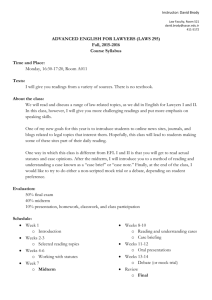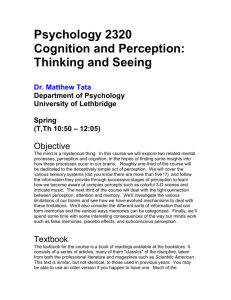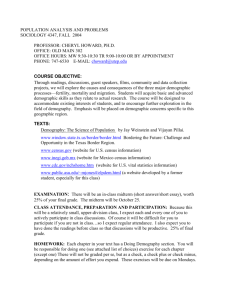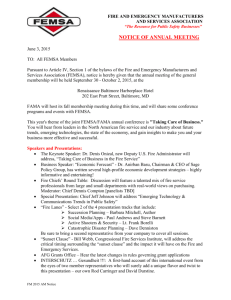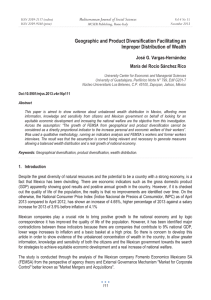STRATEGIC ANALYSIS AND ACTION
advertisement
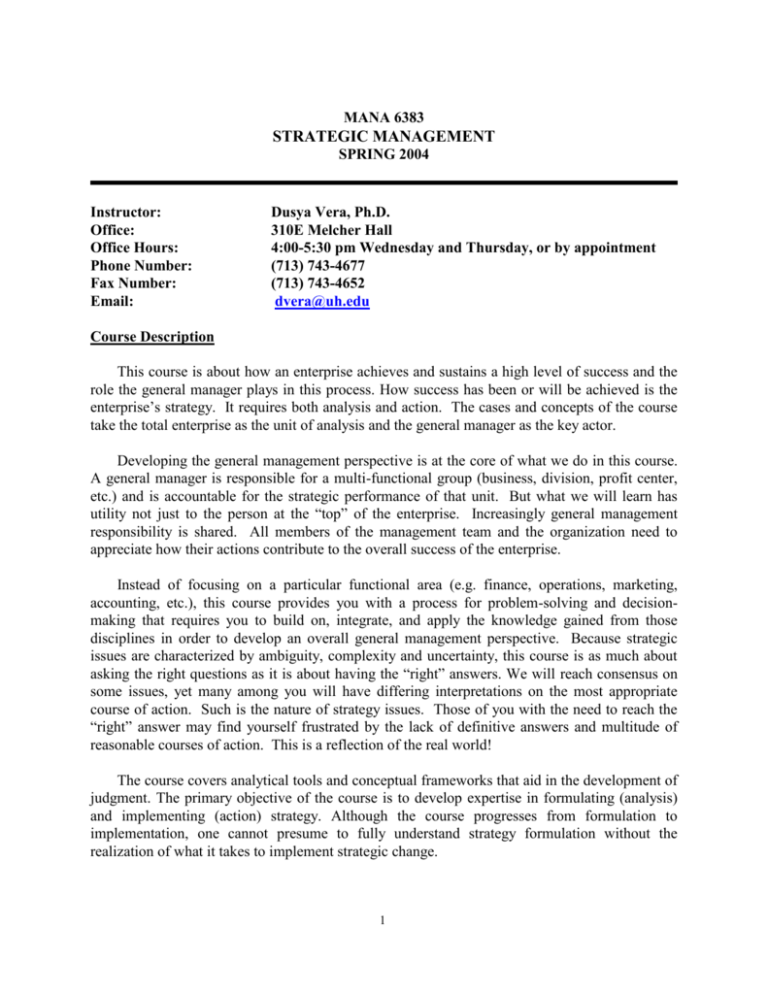
MANA 6383 STRATEGIC MANAGEMENT SPRING 2004 Instructor: Office: Office Hours: Phone Number: Fax Number: Email: Dusya Vera, Ph.D. 310E Melcher Hall 4:00-5:30 pm Wednesday and Thursday, or by appointment (713) 743-4677 (713) 743-4652 dvera@uh.edu Course Description This course is about how an enterprise achieves and sustains a high level of success and the role the general manager plays in this process. How success has been or will be achieved is the enterprise’s strategy. It requires both analysis and action. The cases and concepts of the course take the total enterprise as the unit of analysis and the general manager as the key actor. Developing the general management perspective is at the core of what we do in this course. A general manager is responsible for a multi-functional group (business, division, profit center, etc.) and is accountable for the strategic performance of that unit. But what we will learn has utility not just to the person at the “top” of the enterprise. Increasingly general management responsibility is shared. All members of the management team and the organization need to appreciate how their actions contribute to the overall success of the enterprise. Instead of focusing on a particular functional area (e.g. finance, operations, marketing, accounting, etc.), this course provides you with a process for problem-solving and decisionmaking that requires you to build on, integrate, and apply the knowledge gained from those disciplines in order to develop an overall general management perspective. Because strategic issues are characterized by ambiguity, complexity and uncertainty, this course is as much about asking the right questions as it is about having the “right” answers. We will reach consensus on some issues, yet many among you will have differing interpretations on the most appropriate course of action. Such is the nature of strategy issues. Those of you with the need to reach the “right” answer may find yourself frustrated by the lack of definitive answers and multitude of reasonable courses of action. This is a reflection of the real world! The course covers analytical tools and conceptual frameworks that aid in the development of judgment. The primary objective of the course is to develop expertise in formulating (analysis) and implementing (action) strategy. Although the course progresses from formulation to implementation, one cannot presume to fully understand strategy formulation without the realization of what it takes to implement strategic change. 1 Ultimately strategic choices represent a tension between what an organization needs to do given its competitive and market environment, what it can do given its resources and capabilities, and what it wants to do given the values and preferences of key stakeholders. The overarching framework that guides this course is provided below. The flow of the course is sequenced around this framework. Management Preferences WANT Goals Value Proposition Product/ Market Core Activities CAN Resources & Capabilities NEED Industry Analysis Course Objectives 1. To understand the factors which affect a firm's overall competitive position. 2. To develop an appreciation of the complexity of the issues facing managers with business unit responsibilities. 3. To learn how to formulate and implement strategies aimed at achieving and sustaining superior competitive performance over the long term. 4. To develop the analytical and persuasion skills needed to convince others of this strategy. Assumptions and Expectations Studying the experiences of real companies and the actions of practicing general managers develops insight into, and good judgment about complex strategy situations. We do this through 2 the case method. To the extent possible we must place ourselves into these situations; decide what we would do in the circumstance and be prepared to explain our proposed course of action. To get the most from this course you must actively engage the learning process. This means devoting time and energy to preparation before class and then, during class, listening to others, and being willing to put forward and explain your point of view. The study questions assigned with each case are designed to guide and stimulate your analysis and preparation. They are not “assignments” to be handed in. The textbook and readings assigned are your responsibility. They will not usually be covered in detail during class but will be utilized as they apply to the issues at hand. ‘Lecturettes’ may be used throughout the course to supplement the case discussion. The case discussion process works best if we are prepared to observe some basic ground rules. Most of the case studies we will be working on in this course are undisguised. We will be dealing with real people and the real company. This encourages engagement in the case situations and facilitates follow-up on developments subsequent to the case events. It also creates some potential disadvantages that I would like to ensure we minimize. The process of analyzing, discussing and learning from cases depends in a significant way on discovery - discovering what the real opportunities and problems in the case are as it currently stands, discovering and evaluating the possible ways of dealing with them, and discovering the lessons that can be drawn for continuing use. The value of this process is diminished if we shortcircuit it by jumping ahead to find out ‘what happened’ before we have done our best to understand the case. Similarly, we lose something when someone with special knowledge of the situation does not respect the necessary process of analysis. Ground Rule #1. Do not call the company, go on the net, talk to students in other sections, or otherwise attempt to find out ‘what happened’ in the case situation. Naturally, it is not just the subsequent events that matter but your thoughts and comments on their implications for our analysis and learning. Ground Rule #2. If you already know something about the industry, the company, or even the case events, use this knowledge carefully with your colleagues (and for that matter, test it carefully before you use it yourself!). If you do have special knowledge please let me know and I will call on you to help us out in class at an appropriate time. Ground Rule #3. During class your attention should be focused on the discussion taking place in the classroom. I will provide you with copies of the overheads used in class. You are encouraged to take a few minutes at the end of class, or at the end of the day and reflect upon what you learned from the class. 3 To assist in class participation and knowing your names, name cards will be used for each student. Except for emergency situations, please turn off all pagers and cellular phones. You are reminded that plagiarism (representing another person’s ideas, writings, etc., as ones own) is a serious academic offence; the penalty can be as severe as expulsion. Whenever you take an idea or a passage from another author, you must acknowledge your debt by appropriately citing your source(s). Academic dishonesty of any kind will not be tolerated. Required Texts Crossan, M.M., Fry, J.N. and Killing, J.P. 2002. Strategic Analysis and Action (5th edition), Toronto: Prentice Hall. Case package available at the bookstore Additional materials will be assigned through WebCT Note: The UH bookstore sells a MANA 6383 custom-package that includes both the book and the cases. Another option for students is to buy the book directly from Amazon.com or Amazon.ca, and buy the cases directly from Harvard Business School, Ivey School of Business, and the Business Enterprise Trust. Use of the WebCT tool WebCT is a password-protected online course management system. In this course, the instructor will use WebCT to: 1. Upload class handouts for students to download. 2. Assign additional readings. 3. Post grades. Each student will view his/her individual grades. To get a WebCT ID and log on to WebCT please go to http://www.uh.edu/webct/ The first time you log on to WebCT your password will be your birthdate (mmddyyyy). You may change your password after you log on to WebCT. Class handouts and readings will be uploaded every Friday. 4 Tentative Course Evaluation POINTS: 93-100 90-92 87-89 Class Contribution Group Midterm Exam Final Exam Total 30 points 30 points 40 points 100 points GRADE: A AB+ GRADE: B BC+ POINTS: 83-86 80-82 77-79 POINTS: 73-76 70-72 60-69 below 60 GRADE: C CD F Class Contribution: It is expected that you will be present and prepared for every class, and willing to share your views in the classroom discussion, both voluntarily and when called upon to do so. You have an obligation to learn the material and to assist in the learning of your classmates. To do so, you must make a meaningful contribution when you have the floor. Summarizing case facts, repeating points already made, or simply agreeing with your classmates’ arguments does not constitute a meaningful contribution. Your goal should be to provide insights that pass the "so-what" test. This can range from helping to sort out the key facts in a complex case and to develop an analysis that builds on prior comments, thereby moving the class discussion forward. Every student is important to the class discussion. It is equally important that we listen to one another and attempt to build upon or constructively critique prior comments. Try to resist the temptation to jump to topics that are not specifically open for discussion. Some of the things that will have an impact on effective participation and on which you will be evaluated include: Are you a good listener? Are your contributions relevant to the discussion? Do your comments relate to the comments of others and to the themes that the class is exploring together? Do your comments add to our understanding of the situation? Are you incisive? Do you cut to the core of the problem? Are you willing to challenge the ideas that are being expressed? Are you willing to test new ideas or are all your comments “save”? (For example, do you repeat case facts without analysis or conclusions or repeat comments already made by someone else?) Do you integrate material from past classes or case discussions where appropriate? Do your comments reflect cumulative learning over the course and the entire curriculum or do you merely consider each case in isolation? The individual cases vary in their analytic difficulty, ranging from evaluating decisions already made (simple) to recommending a decision for a specific issue (more difficult) to 5 defining the issue(s) to be addressed and then recommending a specific choice (most difficult). For these latter two types of cases, you will often find that your understanding of the issues is improved if you put yourself into the position of the protagonist in the case. Cases also vary in their conceptual difficulty, ranging from a single framework that is easily understood (easy) to multiple frameworks or one challenging framework (more difficult) to multiple and challenging frameworks (most difficult). Understanding the cases along these dimensions will help you to prepare more effectively and to allocate your time appropriately. Preparation for the case discussion should begin with a quick reading of the assigned text chapters and the case material. Then, it is worthwhile to review the assignment questions for clues as to what issues require special attention. The next step is to reread the case carefully, taking notes that sort information, facts, and observations under a number of relevant headings. Most cases require that you perform some quantitative analyses. Finally, preparation will include notes that can be used to guide your contribution to class discussions. Please ensure that you have used in your analysis the frameworks, tools, and ideas from the readings and the previous class discussions as appropriate. Doing the reading(s) first is advised. Also ensure that you have exploited the material in the case exhibits as much as possible. Many cases will have a question or two for which you have to make a specific decision recommendation. Your recommendation should be realistic, actionable, and supported by analysis (including numerical where appropriate). You should understand the decision criteria, formulate and evaluate (quantitative and qualitative assessments) alternatives, and select a choice. You should also understand the assumptions that underlie your recommendation. Finally, your recommendation should consider implementation: who should carry out your suggestions, when they should do it, and how. During class, you should be prepared to lead off the discussion of any question in a significant way as well as to discuss salient issues which are not addressed per se in the assigned questions. As in any case discussion, it is crucial that you are well-prepared, listen carefully to others, and build on/critique previous comments. Clearly, you must participate in class if you are going to share your ideas with others. Occasionally, students find that it is easier to participate effectively from the point of view of a particular person or functional area, or to take on the role of devil’s advocate or expert (if expertise is possessed) on the topic. It may be impossible for all students to participate in each class. It is the quality of comments, not the quantity, that is germane. In grading class contributions, I will be assessing the extent to which you have established a meaningful presence in the classroom, over the course of the semester, by making solid contributions on a regular basis. Feedback about class contribution will be offered to students during office hours. Since so much of the learning from a case-based course occurs in the classroom, class attendance and participation is critical. You should understand that frequent absence will seriously damage your class contribution grade. The reasoning behind this apparently very stringent policy is that case classes demand active participation and attendance. If you must miss a class it is your responsibility to arrange with your classmates for briefings, announcements, etc. Below are examples of how your class contributions will be calibrated: 6 Outstanding contributor: Contributions in class reflect exceptional preparation. Ideas offered are always substantive, yield one or more major insights, and provide direction to the class. Arguments are well-substantiated and persuasively presented. If this person were not a class member, the quality of discussion would diminish significantly. Good Contributor: Contributions reflect thorough preparation. Ideas are usually substantive, provide good insights into the topic under discussion, and sometimes provide direction for the class. Arguments reflect clear thinking. If this person were not a member of the class, the quality of discussion would be diminished. Adequate Contributor: Contributions in class reflect satisfactory preparation. Ideas are sometimes substantive, provide generally useful insights, but seldom offer a major new direction for the discussion. Arguments are sometimes presented, and are fairly well-substantiated and sometimes compelling. If this person were not a member of the class, the quality of discussion would be somewhat diminished. Non-participant: The person has said little or nothing in this class to date. Therefore, there is not an adequate basis for evaluation. If this person were not a member of the class, the quality of discussion would not be changed. Unsatisfactory Contributor: Contributions in class reflect inadequate preparation. Ideas offered are seldom substantive, are often off-point, provide few (if any) insights, and give no constructive direction to the class. Clear argument on the topic at hand and/or integrative comments are absent. Occasionally, some students find it difficult to participate effectively in class because of language or other challenges. Please speak with the instructor if class participation is a significant concern for you. Group Midterm Exam (Take-home Case): I will assign a case as a take-home exam. The class will be divided into groups of 5 students for the group midterm exam. You will have 2 weeks to form your own groups and to give me lists of the requested members - after that time, I will form the groups. Your group will have 1 week to analyze the case and submit one response per group. Your response must respect the following guidelines: maximum 5 pages (excluding exhibits etc.), times new roman 12-point font, double line spacing, and 1-inch margins. To analyze the case, the following structure will help push your thinking: 7 A. Use the Diamond-E framework to identify all of the pertinent problems/issues that management needs to address. B. Perform whatever analysis and evaluation is appropriate. C. Propose an action plan and set of recommendations addressing the issues you identified. Please note that your written report does not have to follow this format. The expectation of the written report is that it will be a memo to the key decision-maker in the case. Final Exam (Take-home Case): There will be a take-home final examination. It will be similar to the midterm exam, in that it will also be a case. It will be different from the midterm exam in that it will be an individual exercise. Deadlines and Length Limits If for extreme circumstances you are going to be late in submitting an assignment, you are expected to contact me. Lateness will result in a penalty in the grade for the project. The penalties are as follows: Minor delay (<1 week) Major delay (1 week or more) -10 points you receive 0 points for the assignment A similar policy is in place for projects that exceed length limits. Minor excesses (10% or less) will normally result in penalties of -5 points, and significant excesses (more than 10%) in a penalty of -10 points. Grading The quality of achievement in the course is measured as follows: "A" indicates superior achievement; "B," indicates average or satisfactory achievement; and "C" represents a passing grade with very disappointing performance. Plus and minus grades will also be assigned. Accommodations for Students with Disabilities The Center for Students with Disabilities provides a wide variety of academic support services to all currently-enrolled UH students who have any type of mental or physical disability or either temporary or permanent nature. If you feel you may need assistance of this nature, you may wish to call the Center at 3-5400. In addition, you should let me know about any special needs as soon as possible. 8 Instructor Evaluations The CBA has a policy that requires all of its instructors to be evaluated by their students. The results of these evaluations are important to provide feedback to instructors on how their performance can be improved. In addition, these evaluations are carefully considered in promotion, salary adjustment, and other important decisions. We openly encourage students to provide constructive feedback to the instructors and to the CBA through the evaluation process. 9 TENTATIVE COURSE OUTLINE PART 1: STRATEGIC ANALYSIS Module 1: Introduction to Strategy In this section, we consider the role of the general manager in the success of the organization and introduce the basic concepts of strategy. Jan 21/22 Module 2: Overview of Diamond E framework Readings: Chapters 1, 2, 3 Environmental Analysis This module explores how the firm’s environment affects company performance. Overall, there are two concerns that are central to business unit strategy. The first is the structural characteristics and attractiveness of the industry in which the firm competes. A central premise is that all industries do not offer equal opportunities for sustained profitability. The second concern is the firm's position within its industry. Competitive position determines the firm's long-run performance against the industry average. Superior competitive positions are the result of many factors, but ultimately derive from investments in resources, assets, and other capabilities that generate superior value for customers. In the long run, however, above average profits are only sustainable where they involve activities that are difficult for competitors to imitate or substitute for, and where the value of those activities can be appropriated by the firm. Jan 28/29 Case: Cola Wars Continue: Coke vs. Pepsi in the 1990s Readings: Chapters 4, 5 Feb 4/5 Case: Matching Dell Feb 11/12 Case: Wall Street Journal: Print vs. Interactive Deadline to form teams for the midterm case exam Module 3: Resources and Capabilities Analysis In the resource section we lower the microscope on how resources and capabilities are utilized in a strategic context. There are many lenses that we could apply including understanding the distinction between tangible and intangible assets as sources of competitive advantage, understanding the internal value chain of the business, understanding how opportunities can drive capabilities, and how unique resources and capabilities can be leveraged. Finally, we will 10 try to gain an understanding of how resources and capabilities change, or fail to change in light of changes in the industry. Feb 18/19 Case: Harlequin Enterprises Limited Readings: Chapter 6 Feb 25/26 Case: Starbucks Module 4: Management Preferences Analysis This module further develops the notion of success. In building value for the firm, management often has a number of choices. Their personal preferences and those of their stakeholders (shareholders, customers, and employees) often shape their decisions. This module recognizes the importance of management preferences, the potential for competing interests, and how these preferences can shape organizational success. March 3/4 Case: Merck Readings: Chapter 7 Module 5: Organizing to Deliver Strategy This module examines the components of organization (structure, systems, staffing and leadership) to understand how they support or fail to support strategy. March 10/11 Case: Lincoln Electric Readings: Chapter 8 Midterm case exam will be assigned March 17/18 No class: Spring holidays Module 6: Scope of the Firm This section examines the leveraging of resources and capabilities that expand the scope of the firm, vertically, horizontally, or geographically. March 24/25 Case: Labatt-Femsa: Amigos for Growth? Midterm case exam is due 11 Module 7: Comprehensive Analysis In this final formulation module, we will integrate the previous modules to formulate a firm’s strategy. In doing so, you will need to decide: 1. What does the firm need to do (environmental analysis), 2. What can the firm do (resources and capabilities analysis) 3. What does the firm want to do (stakeholders). March 31/April 1 Case: Nestle-Rowntree Readings: Chapter 9 PART II: IMPLEMENTING STRATEGY Module 8: Managing Strategic Change This module puts the strategy that you formulated in the first part of the course into action. We focus on how change in either the environment or the firm makes the strategy dynamic. The need for change is tied back to the success of the enterprise and we examine the general manager’s role in implementing strategic change. April 7/8 Case: Westmills Carpets Limited Readings: Chapter 10 April 14/15 Case: Silent Witness Module 9: Personal Action The final module brings strategy down from the level of the CEO to the lower echelons of the organization. This view from the middle presents a more challenging perspective on strategy as it co-mingles the day-to-day operating issues with strategic issues. This module surfaces the challenges of getting the job done with a strategic perspective. Having developed a fuller understanding of what it takes to implement strategy throughout the organization we can cycle back to strategy formulation with a better sense of what is possible. April 21/22 Case: GE Energy Management Initiative Readings: Chapter 11 Final case exam will be assigned April 28/29 Case: Sabena Belgian World Airlines, Weytjens’ First Assignment May 5/6 Final case exam is due 12 STUDY QUESTIONS COLA WARS CONTINUE: COKE VS. PEPSI IN THE 1990s 1. Why is the soft drink industry so profitable? 2. Compare the economics of the concentrate business to the bottling business: Why is the profitability so different? Why do concentrate producers want to vertically integrate into bottling? 3. How has the competition between Coke and Pepsi affected the industry’s profits? 4. Will Coke and Pepsi sustain their profits through the late 1990s? What would you recommend to coke to insure its success? To Pepsi? MATCHING DELL 1. How and why did the personal computer industry come to have such low average profitability? 2. Why has Dell been so successful despite the low average profitability in the PC industry? 3. Prior to the efforts by competitors to match Dell (1997-1998), how big was Dell competitive advantage? Specifically, calculate Dell’s advantage over the team of Compaq and a reseller in serving a corporate customer. 4. How effective has competitors been in responding to the challenge posed by Dell’s advantage? How big is Dell’s remaining advantage? 5. What should each of Dell’s major rivals do now? WALL STREET JOURNAL 1. Evaluate the print and electronic publishing industries. How has technology altered the structure of the industry? How are the two industries likely to change in the future? 2. What does it take to be successful in print publishing and in electronic publishing? 3. As Peter Kann, the CEO of Dow Jones, how would you evaluate the potential for the interactive Journal to substitute or complement the print edition? Given this, how would you position, price and promote the two editions in the short and long-term in order to maximize returns for both editions? HARLEQUIN ENTERPRISES LIMITED 1. What are the opportunities for growth and profit in the romance novel business? What key success factors must a firm meet to be successful in the business? 13 2. Assess and account for Harlequin’s performance to date. Prepare a five year “no change” scenario for the company’s activities in the romance novel business. 3. What pressures will Larry Heisey be feeling in the early 1980s? 4. As a shareholder, what advice would you offer to Larry Heisey? STARBUCKS 1. What is Starbucks’ strategy? 2. Giver your assessment of its competitive premise, how should it leverage its resources and capabilities to achieve its growth objective? 3. How will you respond to McDonald’s offer? MERCK 1. How are the individuals (groups) with an interest in the decision to invest in research toward a treatment for river blindness? 2. What do you expect would be the positions taken by these individuals (groups) and what would be their arguments for/against funding the research? 3. As Roy Vagelos how would you weigh the positions of the individuals (groups)? What is your decision on the investment proposal? LINCOLN ELECTRIC 1. Why has Lincoln Electric been so successful? Point specifically to contributory factors in Lincoln’s environment, strategy, and organization. Of these, which do you believe has been of greatest importance? 2. How well do you think Lincoln will fare in the next 15 years? What, if any, changes do you think will be essential for a positive forecast? What obstacles do you anticipate in making those changes? LABATT-FEMSA: AMIGOS FOR GROWTH? Please prepare this case first, from the general perspective suggested in Questions 1 and 2, and second, from the specific perspective assigned to you in the class. All participants: 1. What are the essential realities of the brewing industry and economics in the three countries the U.S., Canada, and Mexico - market trends, competition, regulatory matters, and so on? 14 2. What are the implications of the emerging international alliance structures among the major brewers in North America for Labatt, Miller and FEMSA? Labatt Management Perspective: Please take the position of the Labatt management. You will be asked to ratify or change the proposal under development and respond to feedback on it. 1. Review your motivations for pursuing an equity alliance with FEMSA Cerveza. What do you expect to achieve through such an arrangement? Are you comfortable that your expectations are realistic and defensible? 2. Review the terms of the provisional approach that has been developed to propose to FEMSA. Are you comfortable with the financial and managerial elements of this approach? What, if any, elements of this approach would you change before a presentation to FEMSA? 3. If FEMSA were to ask, for whatever reason, for improvements in the terms of the arrangement, what enrichments, if any, would you be prepared to accept? From the Miller Perspective: Please take the position of Miller Brewing management. You will be asked whether you want to enter into negotiations with FEMSA and, if so, what your proposal would be. 1. Are you interested in pursuing some form of alliance with FEMSA Cerveza? What would you expect to achieve through such an arrangement? What would such an arrangement be worth to you? 2. If the Labatt initiative and the general terms of their proposal became known to you, what, if anything, would you do? Would you be inclined to propose a transaction of you own, or would you sit this out? If you do go forward, what would be the essential financial and managerial elements of your proposal? From the FEMSA Perspective: Please take the position of FEMSA/FEMSA Cerveza management. You will be asked to decide whether, with whom, and under what terms you would proceed into an alliance agreement. 1. Why are you interested in pursuing an equity alliance with Labatt (or Miller, for that matter)? What do you expect to achieve through such an arrangement? Are you comfortable that your expectations are realistic and defensible? 2. Is the proposal that you understand Labatt will be putting forward acceptable to you? Are you comfortable with the financial and managerial elements of the approach? What, if any, changes would you seek? 3. Would you be inclined to invite a proposal from Miller? Why? What is the ultimate outcome (as between Labatt and Miller) that you are trying to achieve? 15 NESTLE-ROWNTREE (A) 1. Evaluate Nestle’s strategy and performance in the chocolate business to this point in time. How important is the Rowntree acquisition to Nestle? What are the consequences for Nestle if Jacob Suchard succeeds in acquiring Rowntree? 2. Evaluate Rowntree’s strategy and performance in the chocolate business. Why has Rowntree become a take-over target? 3. How important is a friendly acquisition to Nestle? To Rowntree? What are the obstacles in the way of such an event? WESTMILLS CARPETS Assume that you are Derek Mather and that you have just taken over as president of Westmills. Despite your misgivings you want to give this company your best shot. 1. What were the key elements of Morrison’s turn-around strategy for Westmills? What were the key assumptions supporting this strategy? 2. Do a careful analysis of plan versus actual numbers. Morrison’s strategy has gone wrong. Why? 3. What are the problems/obstacles that have to be addressed to get Westmills on the survival track? Is there any hope? What would you focus on if you were Mather? SILENT WITNESS 1. 2. 3. 4. Will SWE be able to achieve its aggressive growth goals? Why/Why not? What is propelling Rob Bakshi’s new vision for the company? What are the key issues in making this vision a reality? How should Bakshi proceed? THE GE ENERGY MANAGEMENT INITIATIVE (A) Take the position of Raj Bhatt: 1. Review your assessment of the attractiveness of the energy management industry and the key success factors for operating in it. Are you comfortable and confident with your conclusions that this is an attractive industry and business opportunity? 2. How does the GE management system work? How does GE Canada fit into this picture? What are the implications of these observations for the development of the energy management business? 16 3. As of the end of the meeting with the GE Supply executives, what are your options for proceeding and what do you intend to do? SABENA BELGIAN WORLD AIRLINES (A) Read Sabena Belgian World Airlines (A) and Weytjens’ First Assignment. 1. What personal, business and environmental factors influence Erik Weytjens’ decisions and actions? In what way? 2. What is your assessment of the situation at Sabena catering and how ready is the organization for change? 3. What actions should Weytjens take to resolve the problems in dishwashing? 17 STUDENT INFORMATION FORM Name: ______________________________ Student Number: _________________ E-mail Address: ____________________________ Work Phone: __________________ Home Phone: ___________________ May your social security number (last 4 digits) be used for grade posting? Social Security Number: __________________ Yes No Signature: ___________________ Educational Experience: Degree: ___________________________ Date: _______ School: _______________________ ___________________________ _______ _______________________ Current Degree Program: _____________________ Major/Specialization: _________________ Number of hours taking this semester: __________ Expected graduation date: ______________ Work Experience: Current Position: _______________________________ How long? __________________ Current Employer: ______________________________ How long? __________________ Nature of duties: ____________________________________________________________ Previous Position: _______________________________ How long? __________________ Previous Employer: ______________________________ How long? __________________ Nature of duties: ____________________________________________________________ Career/Personal goals: ______________________________________________________ List of countries in which you have lived and how long: _____________________________________________________________________________ 18
